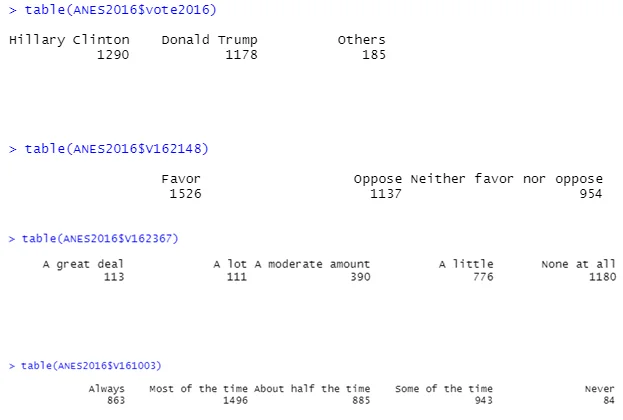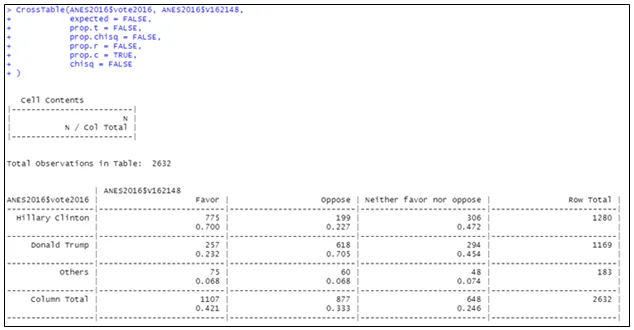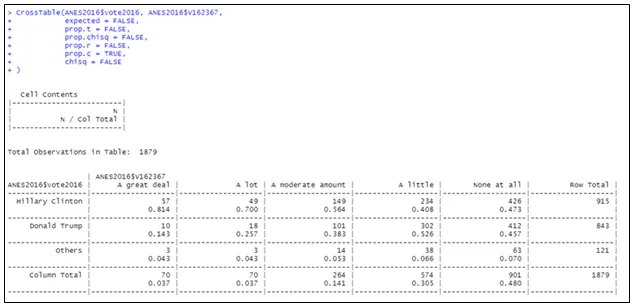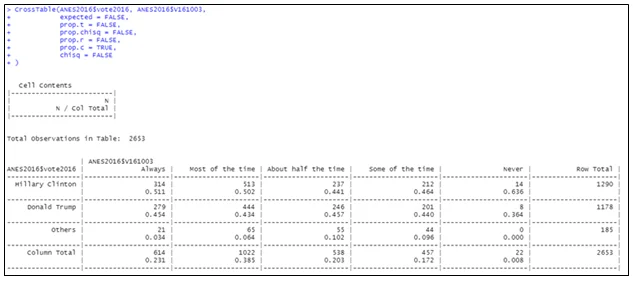The provided R script reads and preprocesses survey data to analyze the factors that may influence voter preferences in the 2016 Presidential election. It then creates frequency tables and crosstables to examine the relationships between these variables and the choice of presidential candidate. The analysis aims to verify hypotheses related to income inequality, personal discrimination, and political engagement, and how they may affect voter behavior. The results are presented in an organized and structured manner for easy interpretation.
Problem Description:
The R Programming homework involves analyzing the relationship between voters' preferences for the 2016 U.S. presidential election and several independent variables. The dependent variable is "For whom did R vote for President," and the independent variables include:
- "Does R favor or oppose government reducing income inequality."
- "How much discrimination has R faced personally."
- "How often does R pay attention to politics and elections."
The goal is to understand how these independent variables might influence voters' choices in the 2016 presidential election.
Solution
Variables
- Dependent: V162034a - For whom did R vote for President
- Independent:
V162148 - Does R favor or oppose govt reducing income inequality
- This is more of a Bernie Sanders campaign strategy, so this may influence Democrat’s voter turnout (in favor selecting Clinton).
V162367 - How much discrimination has R faced personal
- Among the 3 top candidates for Presidency, Trump may be the most vocal about his stand towards multiracial Americans, or other races in general. Thus, R’s answer to this may be correlated with R’s choice of president (selecting anyone other than Trump).
V161003 - How often does R pay attn to politics and elections
- This may be an objective approach to selecting the president, although, it may also just be an indication of R’s biasedness towards a certain candidate. Either way, it may be interesting to know who these Rs prefer the most (equal voter turnout for the top 3).
Frequency Tables

Crosstables



If you are in favor of reducing income inequality by the government, then you are more likely to vote for Clinton (70%) compared to Trump (23.2%). If you faced a great deal of personal discrimination, you are more likely to vote for Clinton (81.4%) compared to Trump (14.3%). If you always paid attention to politics and election, you are more likely to vote for Clinton (51.1%) compared to Trump (45.4%). The first two results supported my hypotheses above while the last one is a bit inclined to Clinton (although they are very close to breakeven).
library(haven)
ANES2016 <- read_stata("C:/Users/USER/Downloads/ordernumbershh5063/Lab 3 Dataset")
#recode some responses (<0) to NA
ANES2016$vote2016 <- ANES2016$V162034a
ANES2016$vote2016 <- replace(ANES2016$vote2016, ANES2016$vote2016 < 0,NA )
ANES2016$vote2016 <- replace(ANES2016$vote2016, ANES2016$vote2016== 7,NA )
ANES2016$vote2016 <- replace(ANES2016$vote2016, ANES2016$vote2016== 9,NA )
ANES2016$vote2016 <- replace(ANES2016$vote2016, ANES2016$vote2016== 4, 3 )
ANES2016$vote2016 <- replace(ANES2016$vote2016, ANES2016$vote2016== 5, 3 )
ANES2016$V162148 <- replace(ANES2016$V162148, ANES2016$V162148 < 0,NA )
ANES2016$V162367 <- replace(ANES2016$V162367, ANES2016$V162367 < 0,NA )
#adding labels
ANES2016$vote2016 <- factor(ANES2016$vote2016,
levels = c(1,2,3),
labels = c("Hillary Clinton", "Donald Trump", "Others"))
ANES2016$V162148 <- factor(ANES2016$V162148,
levels = c(1,2,3),
labels = c("Favor", "Oppose",
"Neither favor nor oppose"))
ANES2016$V162367 <- factor(ANES2016$V162367,
levels = c(1,2,3,4,5),
labels = c("A great deal",
"A lot", "A moderate amount",
"A little", "None at all"))
ANES2016$V161003 <- factor(ANES2016$V161003,
levels = c(1,2,3,4,5),
labels = c("Always",
"Most of the time", "About half the time",
"Some of the time", "Never"))
#creating tables for all variables
table(ANES2016$vote2016)
table(ANES2016$V162148)
table(ANES2016$V162367)
table(ANES2016$V161003)
#creating crosstables
library(crosstable)
CrossTable(ANES2016$vote2016, ANES2016$V162148,
expected = FALSE,
prop.t = FALSE,
prop.chisq = FALSE,
prop.r = FALSE,
prop.c = TRUE,
chisq = FALSE
)
CrossTable(ANES2016$vote2016, ANES2016$V162367,
expected = FALSE,
prop.t = FALSE,
prop.chisq = FALSE,
prop.r = FALSE,
prop.c = TRUE,
chisq = FALSE
)
CrossTable(ANES2016$vote2016, ANES2016$V161003,
expected = FALSE,
prop.t = FALSE,
prop.chisq = FALSE,
prop.r = FALSE,
prop.c = TRUE,
chisq = FALSE
) Similar Samples
Our sample section showcases completed statistics assignments, demonstrating our expertise in solving problems efficiently. You'll find examples of R programming tasks and other statistical challenges, offering insight into the quality and precision of our work. Review these samples to understand our experts approach for delivering accurate, timely solutions.
Statistical Analysis
R Programming
Time Series Analysis
Statistical Analysis
STATA
Econometrics
Statistical Tests
Data Analysis
Biostatistics
SPSS
Econometrics
Statistical Analysis
Statistics
Statistics
STATA
Statistics
Statistical Analysis
R Programming
Business Intelligence
Statistics
